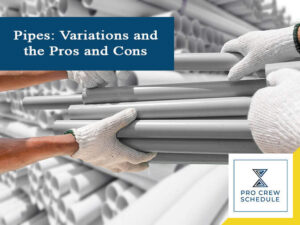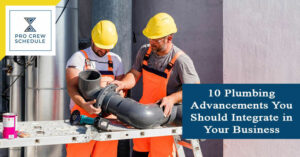When we decide that we want to have a property built, either an office, a building for a business, or a home, we always want to have the best result possible. For this reason, we invest time, effort, and money so that we can hire the best professionals that we can find for the job. As people have different specializations based on their chosen career path or interest, there are things that we do not know. For example, we might not know the best types of cement to build a sturdy house. People might not know what tools to use to install safe and long-lasting electrical systems in their homes. When it comes to plumbing, people might not know the best and safest pipes to use based on its composition and how clients plan to maximize it. That is why when it comes to things like these, the professionals have to help the clients choose what is best. For them to do these, professionals need to be knowledgeable in that certain kind of work, and they need to pass some qualifications. People who work in the plumbing business, for example, are required to attend a vocational school, finish a course, become an apprentice of an expert, and get a license before they are allowed to work. Having these requirements completed ensures that they know what the correct and proper techniques to use are and what kinds of materials such as pipes are necessary and safe depending on where they will be placed and how they are going to be used. Plumbers must ensure that everything goes well from the planning, the installation, and even the maintenance part of the pipes or system.
With their business responsibilities, their co-workers, their family, and their clients; plumbers, especially project managers, have so much on their plate. To lessen the difficulty of managing all of these things and ensuring that everything works for the best, there are now tools, equipment, or builder trends, which are the product of innovation and development accessible to people working in different industries. Some tools can be used in the planning stage and can help save effort and money. Those tools can also be useful in making crew schedule, communication, and recording and keeping important documents and business transactions. Today, Pro Crew Schedule, which is a kind of project management software, is now available. This tool can surely make things in the workplace go smoother, and it can also greatly help with efficiency because of fast information can be sent and access through it. Subcontractors and other managers in charge of monitoring the crew and their tasks will surely be delighted by this software.
More than the regular plumber’s tools, pipes are the most common construction equipment that a plumber is mostly working with Knowing the capacity and quality of each type of pipes and where it can be used best is a skill that every plumber must know.
Here are some of the most used pipes in construction and it’s pros and cons.
1. Polyvinyl Chloride Pipes or PVC Pipes
Polyvinyl Chloride Pipes are composed of a material called thermoplastic polymer or a combination of vinyl and plastic. These pipes are commonly present in colors such as cream, grey, and white. This variation of pipe can be employed in different ways. It is commonly used for water high water pressure. It is also used for draining and for transporting drinking water. This type of pipe’s advantages include its inexpensiveness, can handle high water pressure, not rusting or deteriorating, not challenging to work with, has a long lifespan, etc. But PVC pipes also have disadvantages, including being not useful for handling hot water because the heat can cause the pipes to warp, limited sizing, etc.
2. Copper Pipes
Copper pipe is a type of plumbing pipe that is commonly used from the past until now. This variation of plumbing pipe has two main types, flexible copper tubing and rigid copper. Flexible copper tubing, just like its name, is a kind of copper pipe that is flexible or malleable. This soft copper is mainly employed on supply lines to faucets or in corners, which are tight spaces and need this kind of pipes’ flexible quality. Another kind of copper pipe is rigid copper. Rigid copper is a kind of copper that is hard and is use the water supply system of buildings or houses.
Moreover, a rigid copper pipe can undergo cutting and can also be soldered. A copper pipe has proven its reliability and durability for years, even decades. Its advantages include being not prone to leaks, its long lifespan, its resistance to corrosion, being good for both cold and hot water, being recyclable, being heat tolerant, its safeness (for the copper will not pollute water and bacteria cannot flourish on it), and many more. Although with all of these pros, copper pipes also have disadvantages which include, the possibility of containing a lead-based solder in older houses, its initial price being higher than other materials, its need for additional fitting, it requiring soldering, not being a green product because its manufacturing affects the environment, etc.
3. Cast Iron Pipes
Cast iron pipe is a type of pipe that is exceptionally heavy, durable, and strong. Furthermore, it is commonly used for drainage systems, water, gas, and sewage during the 17th to the 20th centuries. Its advantages include being heat-resistant and durable, reducing sound, being available in different sizes, etc. Its disadvantages, on the other hand include being prone to rusting etc.
4. Stainless Steel Pipes
Stainless steel pipe is a kind of pipe present in rigid and flexible variations, and it also comes in different sizes. This type of pipe also costs more than copper pipes but it is also high in quality. Its advantages include being flexible, being corrosion-resistant, and being strong.
5. Chlorinated Polyvinyl Chloride or CPVC Pipes
Chlorinated Polyvinyl Chloride is a variation of pipe that is similar in composition to PVC pipes. But the main difference between the two types of pipes is that CPVC pipes are chlorinated which allows it to withstand higher water temperatures. CPVC pipes include advantages such it can be easily installed; it is more resistant than PVC pipes, it does not rust, it is cheaper than other types of pipes, it can handle high water pressure, etc. Its disadvantages, on the other hand, include it needs more fittings, it is more expensive than PVC, it is vulnerable when exposed to sunlight for a long time, it can split when the temperature is freezing already, etc.
6. High-Density Polybutylene Pipes or HDPE Pipes
High-density polybutylene pipe is a type of pipe that is commonly employed when working on underground service lines. Its advantages include being corrosion-resistant, being flexible, being durable, etc.
7. Cross-Linked Polyethylene Pipes
Cross-Linked Polyethylene Pipe or PEX pipe is a variation of pipe that is specifically used to supply water. This type of pipe is made up of plastic. It is also flexible, can be easily cut and combined, and can be used continuously in a long time. The advantages of PEX pipes include being extremely flexible, it can be cut easily, it is color-coded (blue for cold water, red for hot water), it is not expensive, it attaches with push-fit plumbing fittings, it can be combined or connected with copper pipes, etc. Its advantages involve it can cause the water to have a taste and odor (especially when the water has sat on the pipes for a long time), it can only be used indoors, it can leak because of the push-fit plumbing fittings, it cannot be recycled, etc.
8. Polybutylene Pipes
Polybutylene pipe is a type of pipe composed of polybutylene, a kind of plastic resin. It was commonly used in the 1970s to the mid-1990s. Its advantages include being easy to manage, inexpensive, etc. At the same time, its disadvantages include being susceptible to leakage at the joints.
9. Galvanized Steel Pipes
Galvanized steel pipe is a type of pipe that is rarely or may not use at all in modern homes because of its negative effects. Houses where galvanized pipes were once installed needs to be re-piped to ensure that the lead is removed. The disadvantages of galvanized steel pipes include, lead can come out in the tap water through the pipes that are corroded, it is prone to clogging which can result to reduced water pressure, there can be water discoloration, the pipes are heavy, pieces of rust can be noticeable in water over time, the zinc coating can cause internal rusting, short lifespan, etc.
Key Takeaways
When deciding what kind of pipe to use, one should consider all the possible factors that can affect the pipe’s performance, and especially its safety. Because of wanting to save money or reduce the cost, people are looking for a cheaper alternative. But suppose we want to save money and look for an alternative; in that case, we must keep in mind that factors such as safety, longevity, and applicability are incredibly significant and should be considered. We can prevent accidents, inconveniences, and the need to spend more money in the future because a pipe broke or because of some other kind of situation. To do this, we should consult a professional about what they think is best, and it will also be good to do some research.







